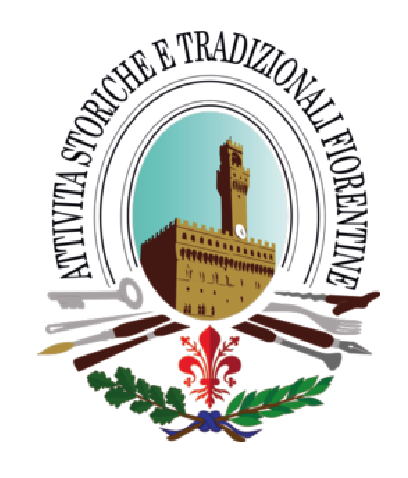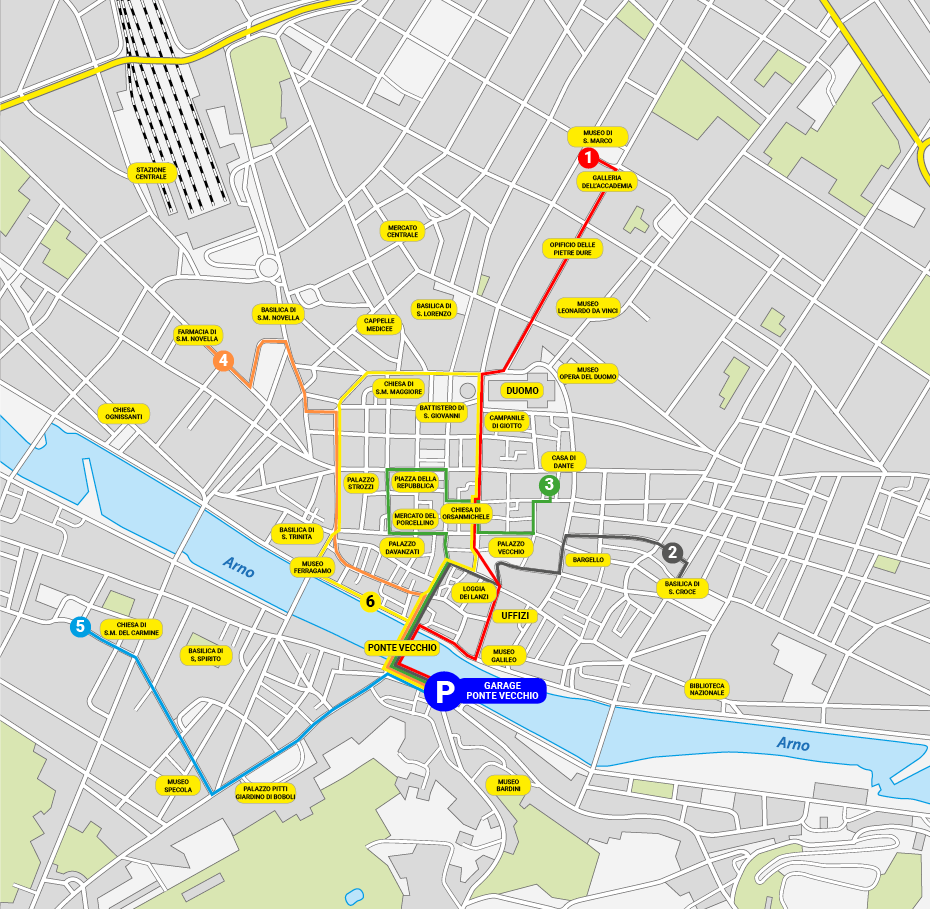


What to see
An immersion inArt, Culture and in Shopping. This part of the historic center, the Roman squares" is undoubtedly the most prestigious and dense of artistic historical content of unparalleled prestige.
Within 700 metres from the Garage Ponte Vecchio, you will have the opportunity to admire the greatest works realized by the ingenuity and the sensitivity of people outside the municipality that gave prestige to Florence and the whole world.
The Duomo, Palazzo Vecchio, Palazzo Pitti, all easily, quickly and easily reachable.
We suggest you a few routes to discover and enjoy this priceless heritage:

To visit the center of Florence and understand its beauty, it would take weeks ...... and you still haven't seen everything. The creation of these courses is the result of the experience and refined knowledge of Dr. Caterina Romei, a lifelong friend and a woman of extraordinary preparation and culture. Six routes specifically designed to discover the center of Florence; short or more structured visits, possibly to be combined, to visit the cradle of the Renaissance without the fear of forgetting the most beautiful and evocative places. If you wish to broaden your knowledge and be guided on personalized and special tours, contact her: caterinaromei6@gmail.com
After crossing the bridge, you can turn right to walk along the Lungarno and in a few minutes you will reach the square of the Uffizi. The huge building, now a world-famous museum, was actually built in 1560 to reorganize the administration of the new grand duchy of Tuscany, given that Cosimo I de Medici had just brought all the Tuscan cities under his dominion and was about to receive the grand ducal crown from the pope.
From the square of the Uffizi you can already clearly see the medieval tower of the palazzo della Signoria, later called palazzo Vecchio, seat of the Florentine Republic since the end of the 1200s and still today the seat of the Municipality of Florence, but also a splendid museum . The palace was built by the architect Arnolfo di Cambio and enlarged over the centuries following, especially at the beginning of the Medici rule, when the square in front of it was also transformed into an open-air museum. Even today you can admire the original statues of the Perseus by Cellini (1545 ) and of Ratto delle Sabine of Giambologna. The David on the square is instead an ancient copy, while Michelangelo's original can be found in the Accademia Gallery .
At the end of the square, take via Calzaioli to go towards the religious center of the city: the piazza del Duomo . Beginning around the year 1000 and ending in the mid-fifteenth century, the Florentines raised the three religious buildings that symbolize the city in the square: the Baptistery of San Giovanni (begun in 1000 and finished at the end of the 13th century), the Cathedral of Santa Maria del Fiore (1294 – 1436) and the bell tower designed by Giotto at the beginning of the fourteenth century.
If you have time, a visit inside the Battistero , with its splendid mosaics and one in the Museum of Opera del Duomo which preserves the original gilded bronze doors of the Baptistery, two of which absolute masterpiece by Lorenzo Ghiberti, as well as many other masterpieces that once they were inside the religious buildings.
Leaving the Bargello continue towards the Franciscan balisica of Santa Croce, the so-called Pantheon of Italy thanks to the many tombs of famous Italians gathered here: Michelangelo, Galileo, Machiavelli, Rossini, to name a few.
The church it is in gothic style and was started by Arnolfo di Cambio in 1294. Inside there are still splendid Gothic frescoes by Giotto and his school, as well as the Crucifix by Cimabue. Included in the ticket is a visit to the cloisters and other areas of the convent.
Going around the market you enter via Porta Rossa and after a few minutes on the left stands the palazzo Davanzati. The building dates back to the mid-14th century and originally belonged to the Davizzi family, then passed on to the Davanzati family and fell into a state of abandonment in the mid-19th century when, thanks to the intuition of a Florentine antique dealer, Elia Volpi, became a museum and showroom, welcoming customers from all over the world. Since 1910 the building has been transformed into the Museum of the Casa Antica. Its structure marks the transition from the medieval tower house to the Renaissance palace, with the loggia on the ground floor used as an office and shop, while the upper floors were inhabited by the family.
Taking the street in front of the building and then turning right you reach piazza della Repubblica, originally the center of the Roman Castrum and seat of the forum. With the unification of Italy and with the passage from Florence of the country's capital, it was unfortunately decided to "renovate" the historic center, creating the square and the buildings that surround it. At the center of the square is the column that marks the center of Roman Florence. Turning to the left (to go back to the Arno), however, you meet of the buildings that have not been affected by the nineteenth-century transformations: the arte della lana, built at the beginning of the fourteenth century and home to one of the most powerful corporations in the city, and the Orsanmichele church behind it. The origins of the church date back to the Lombards, then to the 8th century, who erected an oratory dedicated to San Michele (San Michele in orto). The oratory was destroyed in 1239 and around 1290 Arnolfo di Cambio he built the grain market (this explains the upper floors of the building). The building also became a place of worship, thanks to an image of the Virgin considered miraculous, an image that burned in a fire, which led to the transformation of the building into a church (the new granary was built behind the public building). Marble tabernacles were inserted along the entire external perimeter of the church and within them each Art was called to have its own patron saint executed: the minor arts in marble, the major arts. Today's statues are copies and to see the originals you need to visit the upper floors on Mondays. The works constitute an example of statuary art from the end of the fourteenth century to the end of the sixteenth century. The most important Renaissance artists worked there: Donatello, Brunelleschi, Ghiberti, Giambologna and Verrocchio, only to name a few. Very close to Orsanmichele there is also the so-called House of Dante. In this medieval corner of the city, the Alighieri was born in 1265. The house purchased by the municipality was opened as a museum in 1965.
After crossing the bridge we realize that the buildings near us are modern, in fact rebuilt after the Second World War because they were destroyed by Nazi bombs. However, as soon as we enter the first district on the left, Borgo SS.Apostoli , here we are immersed in medieval Florence. Walking with your nose upwards you can in fact admire the 12th and 13th century tower houses, home to rich Florentine families. At the entrance to the road there is the torre dei Baldovinetti and then the tower-houses of the Buondelmonti, located by Dante in the Paradise of his Commedia. Continuing on, a small square opens up on the left, called piazza del Limbo, where in the early Middle Ages, unbaptized infants were buried. Here stands the chiesa dei SS.Apostoli, dating perhaps in the time of Charlemagne. A simple Romanesque facade that matches the simplicity of the interior, embellished by a Renaissance portal like some of the internal chapels, decorated in the Renaissance by the families of Acciaiuoli and above all of Altoviti, whose building is attached to the church and shows the coat of arms with the rampant dog. Continuing through Borgo Ss. Apostoli you arrive at the column of justice , erected in 1570 to honor the appointment of Cosimo I de Medici to grand duke of Tuscany. On our left one of the oldest private buildings in the city: Palazzo Spini- Feroni- Ferragamo , now home to the design section of the famous brand's fashion collections. However, the building dates back to the end of the thirteenth century and has splendid Baroque frescoes inside. In front of it the church of SS.Trinita, showing the its Renaissance facade created by Buontalenti in the mid-sixteenth century, while at its inside you can see the simplicity of the Romanesque accompanied by splendid frescoes of the fourteenth and fifteenth centuries. Among all, the last chapel on the right in the transept stands out: the cappella Sassetti, frescoed by Ghirlandaio in the 1480s with scenes from the life of St. Francis. Francesco Sassetti had himself, his wife, family and friends painted of him by confusing them in the stories of the saint's life. Francesco and his wife Nera are kneeling on the sides of the altarpiece and their elegant black porphyry sarcophagi inserted into the side walls of the chapel.
Leaving the church and walking north via Tornabuoni, you meet many other Renaissance palaces, including the majestic palazzo Strozzi, which began around to 1486, today home to interesting contemporary exhibitions. At the end of the street stands the simple but elegant palazzo Antinori, again today owned by the same family and headquarters of their business. The Antinori have in fact been producers of wine since the mid-fourteenth century and are today the largest owners of land cultivated with vines in the world. Inside the building you can taste the production in the refined Cantinetta Antinori. Taking the street to the left of the building, you will arrive in a few minutes in the Piazza di Santa Maria Novella where the homonymous church stands. The Basilica of Santa Maria Novella was begun at the end of the thirteenth century and became one of the most important monasteries of the city and cultural center entrusted to the Dominican fathers. The majestic facade was built in the second half of the fifteenth century by Leon Battista Alberti and was commissioned by the wealthy banker and scholar Giovanni Rucellai. Its name and date stand out in Latin in the upper part of the facade itself, demonstrating the role that Rucellai occupied in Florentine society. The church and its convent now house a splendid museum with works by Giotto, Masaccio, Ghirlandaio and Paolo Uccello. Leaving the church and taking via della Scala, one also arrives at the Pharmacy of Santa Maria Novella, managed today by private individuals, but born as a convent workshop for the production of medicines, perfumes and liqueurs. The production is still based on the original recipes today. (Free Entrance)
The palace was bought around 1555 by Eleonora di Toledo, wife of the Duke Cosimo I , who wanted their children to be provided with a residence suitable for their rank. It was Eleonora who called the first architects to enlarge the building and create the garden behind her. The palace passed to the Lorena when the Medici dynasty died out and subsequently to the Savoy who lived there until the 1920s. The interior of the palace is divided into several museums. It is advisable to start from the ground floor and from the Medici treasure, housed in the summer apartment of Ferdinando II Medici, who wanted it richly frescoed in the mid-seventeenth century. Rich frescoes also decorate the ceilings of the galleria Palatina on the first floor, as well to which we can admire paintings by Raffaello, Tiziano and Rubens, to name only the most famous. In the building it is also possible to visit the Modern Art Gallery< /a> on the second floor, full of 19th and early 20th century Italian painters, among which the group of Macchiaioli and the costume museum a>, the first Italian museum to deal with fashion. With another ticket you can enter the Giardino di Boboli, with the its caves, fountains and amphitheater. From Giardino di Boboli, using the same ticket, you can also the visit of the Giardino Bardini, donated to the state by a famous Florentine antique dealer , which offers one of the most beautiful views of the city.
Florence became the capital of Italy for six years, from 3 February 1865 to 3 February 1871. Palazzo Vecchio welcomed the Chamber of Deputies (in the salone dei Cinquecento ) and the Ministry of Foreign Affairs; the Uffizi the Senate of the Kingdom; Palazzo Medici Riccardi the Presidency of the Council and the Ministry of the Interior.
King Vittorio Emanuele II of Savoy, chose as private rooms of the Palazzo Pitti the side of the sundial, which allowed freedom of movement and also privacy when exiting and entering the building.
From piazza Pitti you enter the Sdrucciolo di Pitti (sdrucciolo in Tuscan means: small road going downhill with danger of slipping) to arrive, always going straight, to < a href='https://it.wikipedia.org/wiki/Piazza_Santo_Spirito' target='_blank' data-action='frame'>piazza Santo Spirito, a noisy square, full of life and clubs, much loved by the Florentines. Here stands the Basilica di Santo Spirito with its simple white facade . It is one of the Florentine Renaissance churches that has best preserved that character of simplicity, austerity and mathematical rigor, even if the project by Brunelleschi was partly changed during construction. The museum next to the church houses the wooden Crucifix, an early work by Michelangelo, who came to dissect corpses right in the convent at the age of 15.
On the opposite side of the church, take a right to continue towards piazza del Carmine, where the homonymous church stands. The Basilica del Carmine is one of the five great Florentine churches started at the end of the thirteenth century, but was partially destroyed by a fire in 1700. The internal decoration dates back to the eighteenth-century reconstruction, except for the cappella Brancacci (for visits, enter to the right of the church). Masterpiece by Masaccio and Masolino, the chapel was begun in 1424 and never completed due to the exile inflicted on its client. Despite this, the frescoes were preserved with great care over the centuries as evidence of early Renaissance painting characterized by great realism and the perfect use of mathematical perspective
via dei Calzaiuoli,
via Por S. Maria ,
via Calimala,
via Roma and all the roads and streets that connect them are dotted and enhanced by activities for all needs. The other thing that makes this experience unique is the alternation of shops, workshops and craft activities in an open-air museum atmosphere in which one passes with extreme ease from the image of a monument to that of a sumptuous and refined showcase.